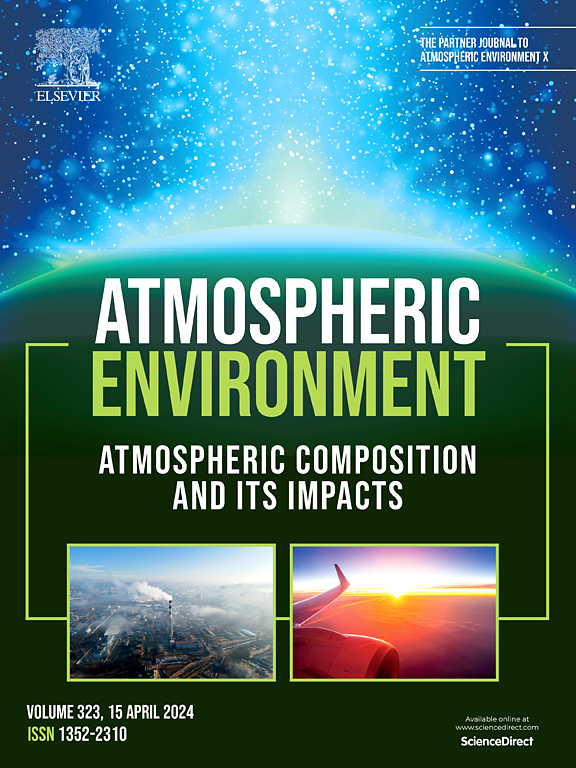Atmospheric carbon dioxide over the Arabian Peninsula: Variability and associated sources
IF 4.2
2区 环境科学与生态学
Q2 ENVIRONMENTAL SCIENCES
引用次数: 0
Abstract
This study uses near-decade-long OCO-2 satellite measurements of column-averaged dry-air carbon dioxide (CO2) mole fraction (XCO2) to understand CO2 dynamics across the Arabian Peninsula (AP). The XCO2 over the AP exhibits strong seasonality, with considerably high and low concentrations during spring and autumn, respectively. Local CO2 fluxes, predominantly from anthropogenic sources, do not display seasonal variations, resulting in minimal impact on the seasonal XCO2 cycle across the AP. Analyses of CarbonTracker model outputs reveal a considerable north-to-south transport of CO2, mainly from Europe and adjacent areas and confined between the low and middle levels of the atmosphere. The seasonal XCO2 cycle observed in the AP clearly replicates the seasonality of this transport pattern. Furthermore, a cross-correlation analysis shows a lag of approximately 1 month in CO2 concentrations between Europe and the AP, with the former preceding the latter. The transport of CO2 from Europe is influenced by considerable variations in local fluxes across the Europe. From winter to early spring, net positive CO2 fluxes occur due to high respiration, increasing local CO2 levels. Conversely, from summer to early autumn, net negative fluxes arise from enhanced uptake, reducing local CO2 concentrations. These concentrations of CO2 are subsequently transported to the AP, driven by synoptic-scale systems (shamal winds) moving toward the region.
The evolution of El Niño conditions considerably amplifies the XCO2 levels over the AP by up to approximately 1 ppm. Notably, during the peak phase of the recent 2015–2016 El Niño, we noted strongly positive anomalies over the southern latitudes, which subsequently migrated to the AP.
阿拉伯半岛上空的大气二氧化碳:变率和相关来源
本研究使用近十年的OCO-2卫星测量柱平均干空气二氧化碳(CO2)摩尔分数(XCO2),以了解整个阿拉伯半岛(AP)的二氧化碳动态。AP上空XCO2具有较强的季节性,春季浓度较高,秋季浓度较低。主要来自人为来源的当地二氧化碳通量不显示季节变化,因此对整个亚太地区的XCO2季节性循环影响最小。对CarbonTracker模式输出的分析显示,二氧化碳有相当大的由北向南输送,主要来自欧洲和邻近地区,并被限制在大气低层和中层之间。在AP观测到的季节性XCO2循环清楚地复制了这种运输模式的季节性。此外,相互关联分析显示,欧洲和亚太地区的二氧化碳浓度大约滞后1个月,前者在后者之前。来自欧洲的二氧化碳运输受到整个欧洲当地通量的相当大变化的影响。从冬季到早春,由于高呼吸作用,二氧化碳净正通量出现,增加了当地的二氧化碳水平。相反,从夏季到初秋,净负通量来自增强的吸收,减少了当地的二氧化碳浓度。这些浓度的二氧化碳随后在向该地区移动的天气尺度系统(浅风)的驱动下被输送到AP。El Niño条件的演变大大放大了AP上的XCO2水平,最高可达约1ppm。值得注意的是,在最近的2015-2016年厄尔尼诺Niño的峰值阶段,我们注意到南纬地区出现了强烈的正异常,随后向AP迁移。
本文章由计算机程序翻译,如有差异,请以英文原文为准。
求助全文
约1分钟内获得全文
求助全文
来源期刊

Atmospheric Environment
环境科学-环境科学
CiteScore
9.40
自引率
8.00%
发文量
458
审稿时长
53 days
期刊介绍:
Atmospheric Environment has an open access mirror journal Atmospheric Environment: X, sharing the same aims and scope, editorial team, submission system and rigorous peer review.
Atmospheric Environment is the international journal for scientists in different disciplines related to atmospheric composition and its impacts. The journal publishes scientific articles with atmospheric relevance of emissions and depositions of gaseous and particulate compounds, chemical processes and physical effects in the atmosphere, as well as impacts of the changing atmospheric composition on human health, air quality, climate change, and ecosystems.
 求助内容:
求助内容: 应助结果提醒方式:
应助结果提醒方式:


